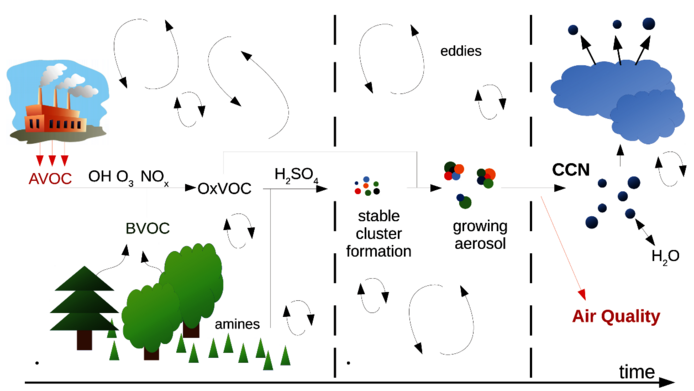Calculating a gap in atmospheric chemistry

Lukas Pichelstorfer, a physicist and Erwin Schrödinger Fellow of the Austrian Science Fund FWF, wants his computer model to close a knowledge gap in the field of atmospheric chemistry, namely the processes leading from volatile organic compounds of known origin to their end product carbon dioxide. He also intends to address gaps between theoretical and experimental atmospheric chemistry, as well as known reaction paths and measured molecules. Comparing the simulation results, based on theory, with experimentally collected data is designed to verify his model. As a consequence, it would be possible to determine different effects of volatile organic hydrocarbons on climate and air quality.
From VOC to HOM
We are all familiar with volatile organic compounds (VOC), e.g. in the form of aromatic hydrocarbons. We can smell them at the filling station (benzene) or as solvents in paints and varnishes (toluene), but also in pinewood forests (pinene). Atmospheric chemistry distinguishes between volatile hydrocarbons of anthropogenic (AVOC) and biogenic origin (BVOC). Whatever the source, too high a concentration of VOCs usually has a detrimental effect on health, ranging from irritations of the eye and respiratory tract to cancer. An aspect common to all VOCs is that they continue to react in the atmosphere. At the end of the atmospheric reaction chains, aromatic hydrocarbons are “burned”, thereby forming the greenhouse gas CO2. In between, AVOCs perform other climate-relevant functions. After an early reaction, the initially volatile substances continue to absorb oxygen, forming what experts call HOMs (highly oxygenated molecules). As regards their properties, these HOMs differ fundamentally from the volatile molecules they started out from. They can contribute to the formation of particles that may serve as condensation nuclei for clouds, but they can also influence air quality. Clouds have a major influence on the climate, which has not been fully researched: “Thus, a better understanding of the role of VOCs in cloud formation is also relevant for climate research. The changes in air quality due to emitted VOCs, in turn, is important for conurbations.”

Known mass – uncertain structure
It has been possible to capture such HOM molecules with highly sophisticated mass spectrometers for several years, but they cannot be described in detail as yet: “We can measure them, but we don't know exactly how they are formed or what their structure looks like, and it is the structure that determines the properties of the molecule. We are developing a model at the interface between theoretical and experimental chemistry, which computes the most probable reaction paths including ramifications and is intended to provide clarity about the molecules found. In the next step, the model is expected to reproduce the peaks determined experimentally from the spectroscope and identify the properties of the molecules that may form in this way,” explains Lukas Pichelstorfer, who is currently conducting research at the Institute for Atmospheric and Earth System Research at the University of Helsinki. In this endeavour, the challenge is to feed the system with theoretical fundamental rules for reactions in such a way that the code can be generated automatically depending on the respective input data and conditions. The researcher chose benzene as his prototype for an aromatic hydrocarbon. He uses around 1700 differential equations that depend on each other and describe the reaction system. Currently, the simulated molecules from the model are compared with measurements under controlled, but varying, conditions. “A model for the formation of HOM by reactions of AVOC in the atmosphere doesn't exist yet. This is a hot research topic. The litmus test for the model is always: does the simulated theory match the practical measurements and the approximate reality of what happens in the atmosphere,” explains Pichelstorfer. To this end, the FWF-Schrödinger Fellow is cooperating with colleagues at various universities. Implementing the code from his programme in existing aerosol dynamics models and chemical transport models will provide information on the contribution of HOMs to the formation and growth of particles in the measuring chamber and in nature.
Real-time atmospheric chemistry
Parameters such as temperature, air pressure, sunlight, the concentration of various gases and many more are impact factors in atmospheric chemistry. The team is already planning reality checks in Istanbul (Turkey) and Nanjing (China). The researchers intend to describe and track “pieces of the atmosphere” above the cities. The models will be used to calculate the chemical and physical processes that take place in the atmosphere, the quality of the air, the toxicity of the substances produced and the number of condensation nuclei for clouds that are generated in this way. The group is already working with city planners to make recommendations as to where it would be better not to build a hospital, nursing home or kindergarten due to high levels of anthropogenic air pollution.
Personal details Lukas Pichelstorfer is an aerosol physicist whose work is both experimental and computer-based. He completed his Master’s thesis in physics at the University of Vienna on the topic of heterogeneous nucleation. For his dissertation at the University of Salzburg he modelled the dynamics of aerosols in the human lung. Since 2019, the FWF Schrödinger Fellow has been investigating the effects of volatile organic molecules in the atmosphere at the University of Helsinki.
Publications





